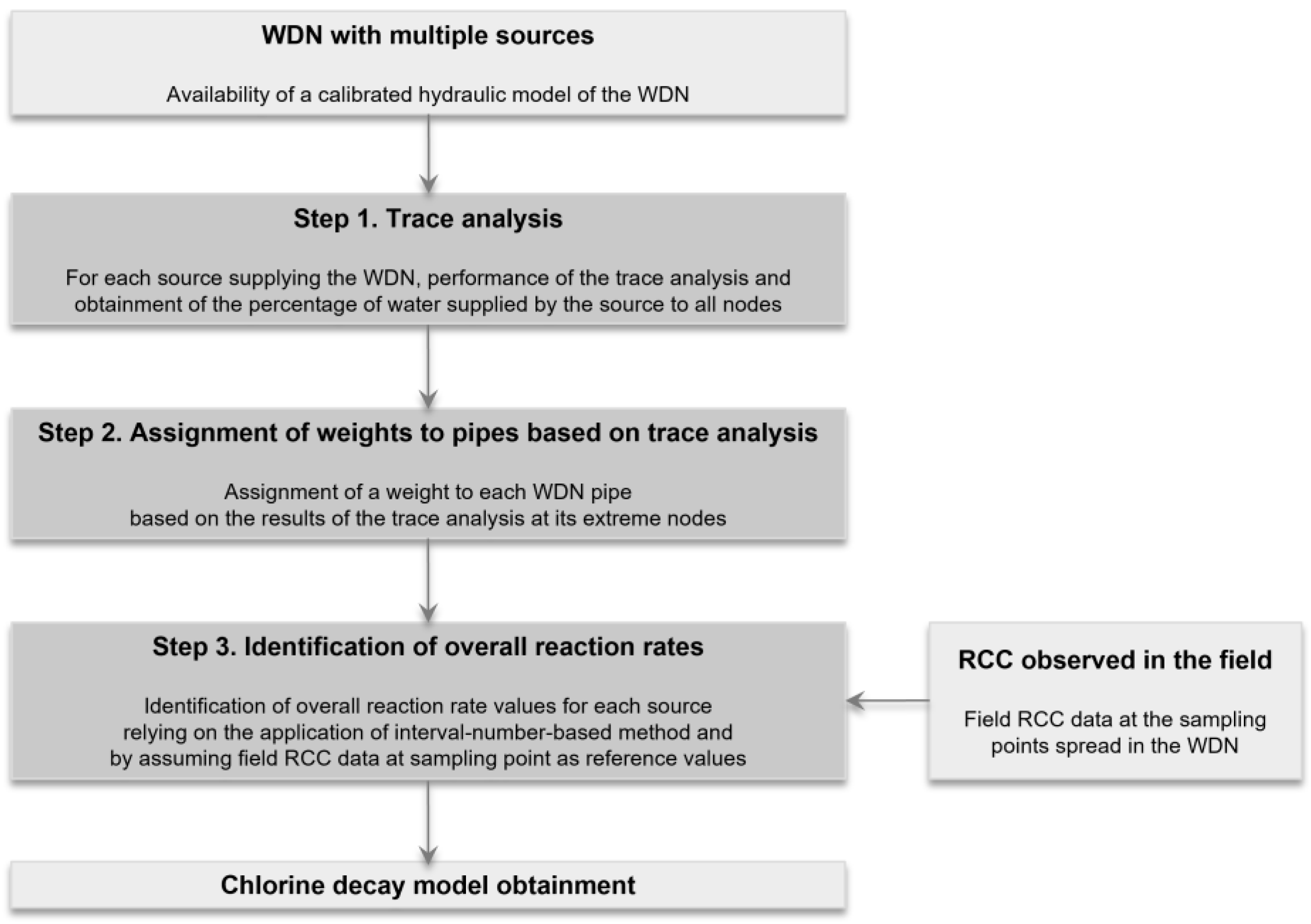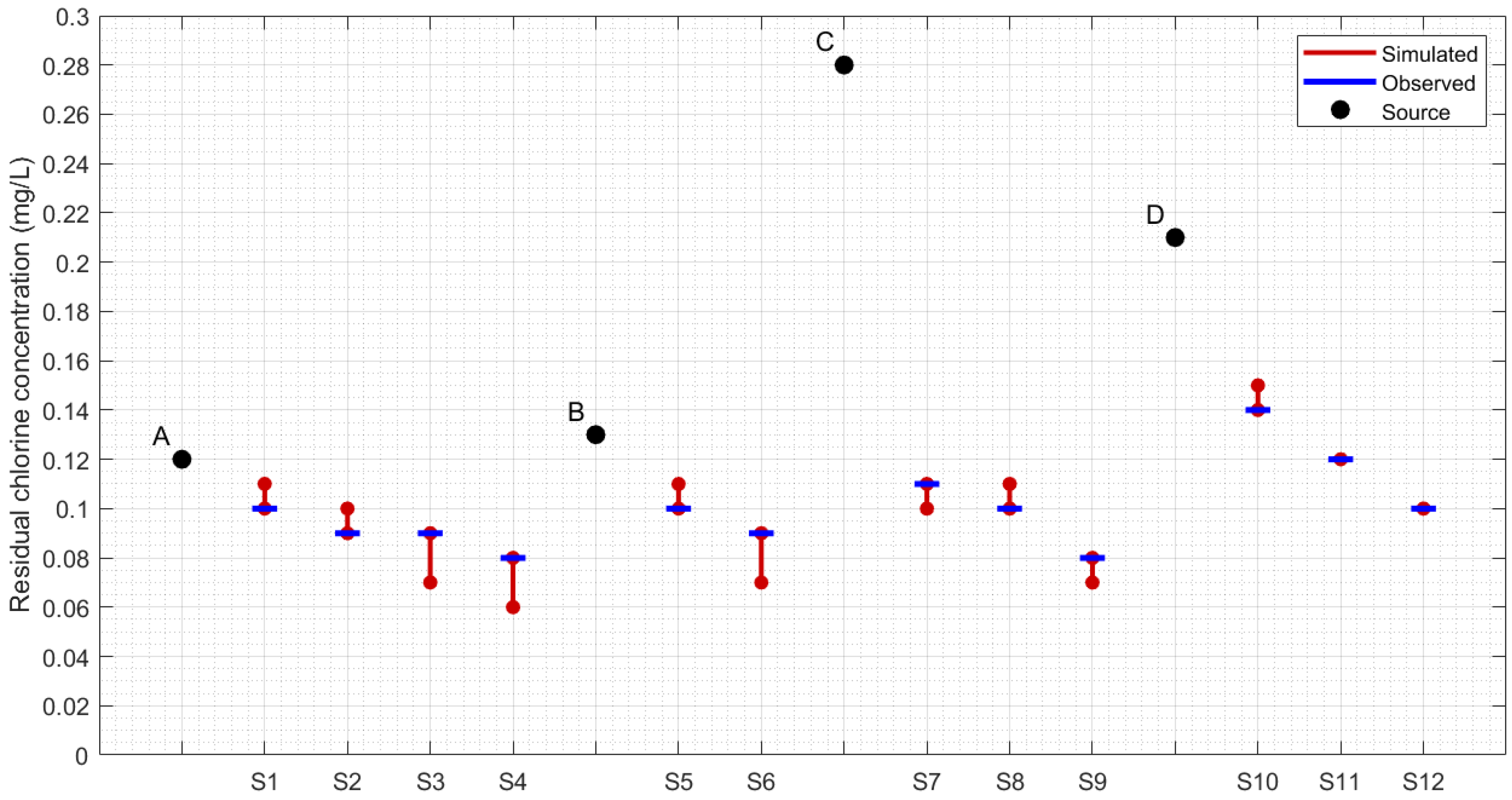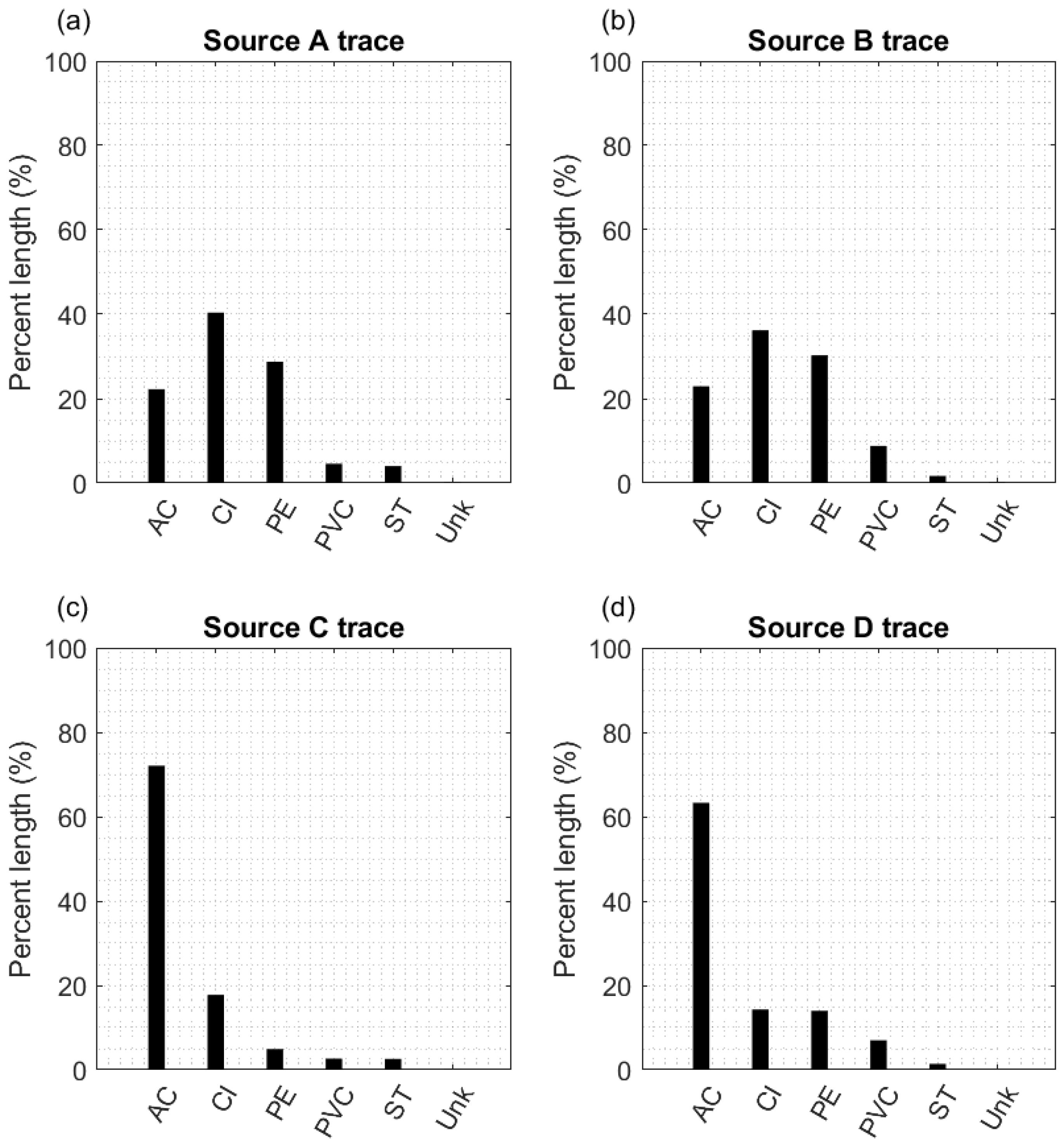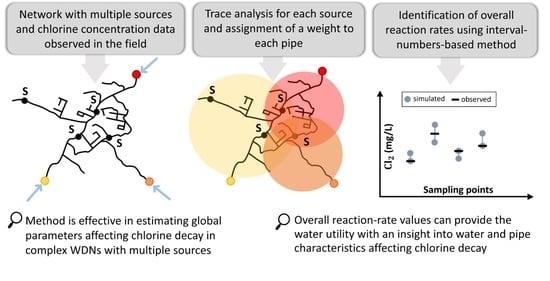A Pragmatic Approach for Chlorine Decay Modeling in Multiple-Source Water Distribution Networks Based on Trace Analysis
Abstract
1. Introduction
2. Materials and Methods
2.1. Methodology
2.1.1. Step 1. Trace Analysis
2.1.2. Step 2. Assignment of Weights to Pipes Based on Trace Analysis
2.1.3. Step 3. Identification of Overall Reaction Rates
- (i)
- An initial-attempt interval is defined for the overall reaction rates related to each source ;
- (ii)
- The lower limit of all the -interval numbers is first considered. A reaction parameter is assigned to each link of the WDN, in turn, based on the weighted average of the overall reaction rates as shown in Equation (4):
- (iii)
- Water quality simulation is performed and the resulting RCC values at each sampling point are considered. In greater detail, given the nature of the chlorine decay reaction, the imposition of the lower limits of the overall reaction rates values would result in the highest simulated RCC values, i.e., ;
- (iv)
- The upper limit of all the -interval numbers is then considered. A reaction parameter is assigned to all the -links of the WDN, in turn, based on the weighted average of the overall reaction rates as shown in Equation (5):
- (v)
- Water quality simulation is performed and the resulting RCC values at each sampling point are considered. In this case, the imposition of the upper limits of the overall reaction rates would result in the lowest simulated RCC values, i.e., ;
- (vi)
- The observed RCC values are compared against the respective RCC ranges obtained through hydraulic simulations, i.e., interval numbers . In the event that all the observed values fall within their respective simulated ranges (i.e., ), the overall process (i.e., phases i–v) is repeated by reducing the amplitude of each interval number . The process stops when the narrowest interval numbers satisfying the above conditions are found. In other words, an interval describing the overall reaction rate for each area supplied by a source is obtained at the end of phase vi.
2.2. Case Study
3. Results and Discussion
4. Study Limitations and Requirements
- Although (i) the main aim of the study here proposed is to provide a pragmatic tool for water quality calibration and (ii) the calibration approach is based on the use of RCC data observed in the field over a reliable period (i.e., in relation to a yearly time window in the case of the Piovese WDN), the unavailability of additional RCC data observed over different periods did not make it possible to further test method performance in subsequent time windows;
- The approach here proposed is based on the use of RCC data collected in the field. Specifically, the installation of at least one RCC sensor per area supplied by a given source is required. In the event that one or many supply areas do not include at least one RCC sensor, model calibration is not possible by means of the interval-number-based method described in this study;
- Although analysis of model sensitivity to overall reaction rate values is not explicitly included in this study, it is worth noting that the interval-number-based nature of the method here presented intrinsically allows one to make considerations about the effects of the overall reaction rate values on RCC spatio–temporal distribution. In greater detail, overall reaction rates are here defined as interval numbers, i.e., ranges, the extreme values of which are adjusted so that all the resulting RCC ranges (obtained from hydraulic simulation) include their related observed values. Overall, the amplitude of these interval numbers reflects the uncertainty related to the respective parameters.
5. Conclusions
- The developed method—relying on the combination of trace analysis and the use of interval numbers—is effective in estimating the value of global parameters affecting chlorine decay (i.e., overall reaction rates) in complex WDNs with multiple sources, a case which had been explored only in a limited manner in the literature;
- Overall, trace analysis (allowing the identification of those areas where waters with different qualitative characteristics are mixed) is demonstrated to be an effective support tool when modeling chlorine decay in WDNs, overcoming the challenge of the complexity related to the multi-source nature of the WDN. Specifically, the application of the proposed approach can be useful to focus the attention on WDN areas potentially subjected to water-mixing processes, where unexpected general chlorine decay can be observed;
- The use of global water quality parameters (i.e., overall reaction rates) allows one to obtain a chlorine decay model capable of accurately representing the spatio–temporal distribution of RCC throughout a complex WDN without the need of specific information on pipe characteristics (i.e., age and material, affecting wall reactions) or water quality characteristics (affecting bulk reaction) which may be difficult to obtain, as widely demonstrated in the literature;
- Indicators such as amplitude and the average value of the interval numbers describing the overall reaction rates can provide water utilities with an insight into the source and WDN characteristics affecting chlorine decay.
Author Contributions
Funding
Data Availability Statement
Conflicts of Interest
References
- Yimer, T.; Desale, T.; Asmare, M.; Endris, S.; Ali, A.; Metaferia, G. Modeling of Residual Chlorine on Addis Ababa Water Supply Distribution Systems. Water Conserv. Sci. Eng. 2022, 7, 443–452. [Google Scholar] [CrossRef]
- Frankel, M.; Katz, L.E.; Kinney, K.; Werth, C.K.; Zigler, C.; Sela, L. A framework for assessing uncertainty of drinking water quality in distribution networks with application to monochloramine decay. J. Clean. Prod. 2023, 407, 137056. [Google Scholar] [CrossRef]
- Schück, A.; Díaz, S.; Lansey, K. Reducing Water Age in Residential Premise Plumbing Systems. J. Water Resour. Plan. Manag. ASCE 2023, 149, 04023031. [Google Scholar] [CrossRef]
- Udokpoh, U.U.; Ndem, U.A.; Abubakar, Z.S.; Yakasi, A.B.; Saleh, D. Comparative Assessment of Groundwater and Surface Water Quality for Domestic Water Supply in Rural Areas Surrounding Crude Oil Exploration Facilities. J. Environ. Pollut. Hum. Health 2021, 9, 80–90. [Google Scholar] [CrossRef]
- Delgado-Aguiñaga, J.A.; Becerra-López, F.I.; Torres, L.; Besancon, G.; Puig, V.; Jiménez Magaña, M.R. Dynamic model for a water distribution network: Application to leak diagnosis and quality monitoring. IFAC-PapersOnLine 2020, 53, 16679–16684. [Google Scholar] [CrossRef]
- Smeets, P.W.M.H.; Medema, G.J.; van Dijk, J.C. The Dutch secret: How to provide safe drinking water without chlorine in the Netherlands. Drink. Water Eng. Sci. 2009, 2, 1–14. [Google Scholar] [CrossRef]
- Mabrok, M.A.; Saad, A.; Ahmed, T.; Alsayab, H. Modeling and simulations of Water Network Distribution to Assess Water Quality: Kuwait as a case study. Alex. Eng. J. 2022, 61, 11859–11877. [Google Scholar] [CrossRef]
- Quintiliani, C. Water Quality Enhancement in WDNs through Optimal Valves Setting. Ph.D. Thesis, University of Cassino and Southern Lazio, Cassino, Italy, 2017. [Google Scholar]
- Abraham, E.; Blokker, E.J.M.; Stoianov, I. Decreasing the discoloration risk of drinking water distribution systems through optimized topological changes and optimal flow velocity control. J. Water Resour. Plan. Manag. ASCE 2017, 144, 04017093. [Google Scholar] [CrossRef]
- Vreeburg, J.H.G.; Boxall, J.B. Discolouration in potable water distribution systems: A review. Water Res. 2007, 41, 519–529. [Google Scholar] [CrossRef]
- Marsili, V.; Alvisi, S.; Maietta, F.; Capponi, C.; Meniconi, S.; Brunone, B.; Franchini, M. Extending the Application of Connectivity Metrics for Characterizing the Dynamic Behavior of Water Distribution Networks. Water Resour. Res. 2023, 59, e2023WR035031. [Google Scholar] [CrossRef]
- Brentan, B.; Monteiro, L.; Carneiro, J.; Covas, D. Improving water age in distribution systems by optimal valve operation. J. Water Resour. Plan. Manag. ASCE 2021, 147, 04021046. [Google Scholar] [CrossRef]
- Quintiliani, C.; Marquez-Calvo, O.; Alfonso, L.; Di Cristo, C.; Leopardi, A.; Solomatine, D.P.; de Marinis, G. Multiobjective valve management optimization formulations for water quality enhancement in water distribution networks. J. Water Resour. Plan. Manag. ASCE 2019, 145, 04019061. [Google Scholar] [CrossRef]
- Garcia, D.; Puig, V.; Quevedo, J. Prognosis of Water Quality Sensors Using Advanced Data Analytics: Application to the Barcelona Drinking Water Network. Sensors 2020, 20, 1342. [Google Scholar] [CrossRef] [PubMed]
- Lu, H.; Ding, A.; Zheng, Y.; Jiang, J.; Zhang, J.; Zhang, Z.; Xu, P.; Zhao, X.; Quan, F.; Gao, C.; et al. Securing drinking water supply in smart cities: An early warning system based on online sensor network and machine learning. AQUA Water Infrastruct. Ecosyst. Soc. 2023, 72, 721. [Google Scholar] [CrossRef]
- World Health Organization. Guidelines for Drinking Water Quality; World Health Organization: Geneva, Switzerland, 2017. [Google Scholar]
- Pérez, R.; Martínez-Torrents, A.; Martínez, M.; Grau, S.; Vinardell, L.; Tomàs, R.; Martínez-Lladó, X.; Jubany, I. Chlorine Concentration Modelling and Supervision in Water Distribution Systems. Sensors 2022, 22, 5578. [Google Scholar] [CrossRef] [PubMed]
- Pecci, F.; Stoianov, I.; Ostfeld, A. Convex Heuristics for Optimal Placement and Operation of Valves and Chlorine Boosters in Water Networks. J. Water Resour. Plan. Manag. 2021, 148, 04021098. [Google Scholar] [CrossRef]
- Moeini, M.; Sela, L.; Taha, A.F.; Abokifa, A.A. Bayesian Optimization of Booster Disinfection Scheduling in Water Distribution Networks. Water Res. 2023, 242, 120117. [Google Scholar] [CrossRef]
- Alsaydalani, M.O.A. Simulation of Pressure Head and Chlorine Decay in a Water Distribution Network: A Case Study. Open Civ. Eng. J. 2019, 13, 58–68. [Google Scholar] [CrossRef]
- Bouzid, S.; Ramdani, M.; Chenikher, S. Quality Fuzzy Predictive Control of Water in Drinking Water Systems. Autom. Control. Comput. Sci. 2019, 53, 492–501. [Google Scholar] [CrossRef]
- Fisher, I.; Kastl, G.; Sathasivan, A. New model of chlorine-wall reaction for simulating chlorine concentration in drinking water distribution systems. Water Res. 2017, 125, 427–437. [Google Scholar] [CrossRef]
- Maleki, M.; Ardila, A.; Argaud, P.-O.; Pelletier, G.; Rodriguez, M. Full-scale determination of pipe wall and bulk chlorine degradation coefficients for different pipe categories. Water Supply 2023, 23, 657–670. [Google Scholar] [CrossRef]
- Minaee, R.P.; Mokhtari, M.; Moghaddam, A.; Ebrahimi, A.A.; Askarishahi, M.; Afsharnia, M. Wall Decay Coefficient Estimation in a Real-Life Drinking Water Distribution Network. Water Resour. Manag. 2019, 33, 1557–1569. [Google Scholar] [CrossRef]
- Al-Araimi, M.M.; Joy, V.M.; Rao, L.S.N.; Feroz, S. Optimization and Assessment of Residual Chlorine using Response Surface Methodology (RSM) and Artificial Neural Network (ANN) Modeling. Int. J. Recent Technol. Eng. 2019, 8, 258–263. [Google Scholar] [CrossRef]
- Moghaddam, A.; Mokhtari, M.; Afsharnia, M.; Minaee, R.P. Simultaneous Hydraulic and Quality Model Calibration of a Real-World Water Distribution Network. J. Water Resour. Plan. Manag. 2020, 146, 06020007. [Google Scholar] [CrossRef]
- Medina, Y.; Muñoz, E. Analysis of the Relative Importance of Model Parameters in Watersheds with Different Hydrological Regimes. Water 2020, 12, 2376. [Google Scholar] [CrossRef]
- Monteiro, L.; Carneiro, J.; Covas, D.I.C. Modelling chlorine wall decay in a full-scale water supply system. Urban Water J. 2020, 17, 754–762. [Google Scholar] [CrossRef]
- Digiano, F.A.; Zhang, W. Pipe section reactor to evaluate chlorine-wall reaction. J. Am. Water Work. Assoc. 2005, 97, 74–85. [Google Scholar] [CrossRef]
- Rossman, L.A.; Woo, H.; Tryby, M.; Shang, F.; Janke, R.; Haxton, T. EPANET 2.2 User Manual; Water Infrastructure DivisionCenter for Environmental Solutions and Emergency Response, U.S. Environmental Protection Agency: Cincinnati, OH 45268, USA, 2020. [Google Scholar]
- Alvisi, S.; Franchini, M. Pipe roughness calibration in water distribution systems using grey numbers. J. Hydroinformatics 2010, 12, 424–445. [Google Scholar] [CrossRef]
- Marín, L.G.; Cruz, N.; Sáez, D.; Sumner, M.; Núñez, A. Prediction interval methodology based on fuzzy numbers and its extension to fuzzy systems and neural networks. Expert Syst. Appl. 2019, 119, 128–141. [Google Scholar] [CrossRef]






| Source | Avg. Inflow (L/s) | Water | Chlorine Concentration (mg/L) |
|---|---|---|---|
| A | 160 | underground aquifer | 0.12 |
| B | 70 | mixed water a | 0.13 |
| C | 20 | surface water | 0.28 |
| D | 60 | mixed water b | 0.21 |
| Source | (1/days) | (1/days) |
|---|---|---|
| A | 0.70 | 1.10 |
| B | 0.40 | 0.50 |
| C | 0.95 | 1.05 |
| D | 0.95 | 1.05 |
Disclaimer/Publisher’s Note: The statements, opinions and data contained in all publications are solely those of the individual author(s) and contributor(s) and not of MDPI and/or the editor(s). MDPI and/or the editor(s) disclaim responsibility for any injury to people or property resulting from any ideas, methods, instructions or products referred to in the content. |
© 2024 by the authors. Licensee MDPI, Basel, Switzerland. This article is an open access article distributed under the terms and conditions of the Creative Commons Attribution (CC BY) license (https://creativecommons.org/licenses/by/4.0/).
Share and Cite
Zaghini, A.; Gagliardi, F.; Marsili, V.; Mazzoni, F.; Tirello, L.; Alvisi, S.; Franchini, M. A Pragmatic Approach for Chlorine Decay Modeling in Multiple-Source Water Distribution Networks Based on Trace Analysis. Water 2024, 16, 345. https://doi.org/10.3390/w16020345
Zaghini A, Gagliardi F, Marsili V, Mazzoni F, Tirello L, Alvisi S, Franchini M. A Pragmatic Approach for Chlorine Decay Modeling in Multiple-Source Water Distribution Networks Based on Trace Analysis. Water. 2024; 16(2):345. https://doi.org/10.3390/w16020345
Chicago/Turabian StyleZaghini, Alice, Francesca Gagliardi, Valentina Marsili, Filippo Mazzoni, Lorenzo Tirello, Stefano Alvisi, and Marco Franchini. 2024. "A Pragmatic Approach for Chlorine Decay Modeling in Multiple-Source Water Distribution Networks Based on Trace Analysis" Water 16, no. 2: 345. https://doi.org/10.3390/w16020345
APA StyleZaghini, A., Gagliardi, F., Marsili, V., Mazzoni, F., Tirello, L., Alvisi, S., & Franchini, M. (2024). A Pragmatic Approach for Chlorine Decay Modeling in Multiple-Source Water Distribution Networks Based on Trace Analysis. Water, 16(2), 345. https://doi.org/10.3390/w16020345











